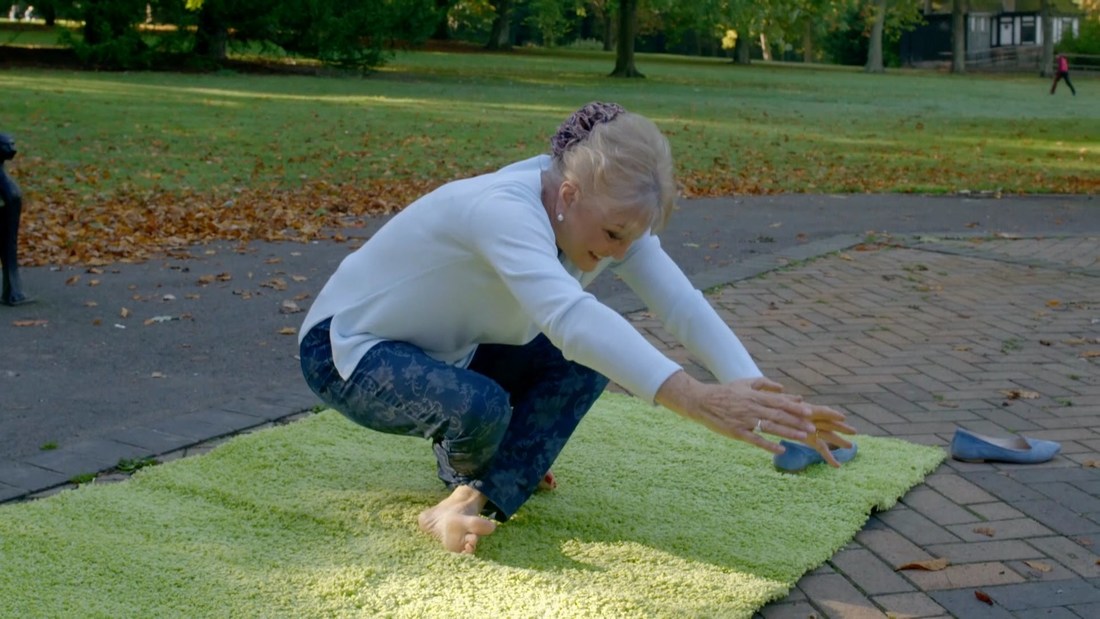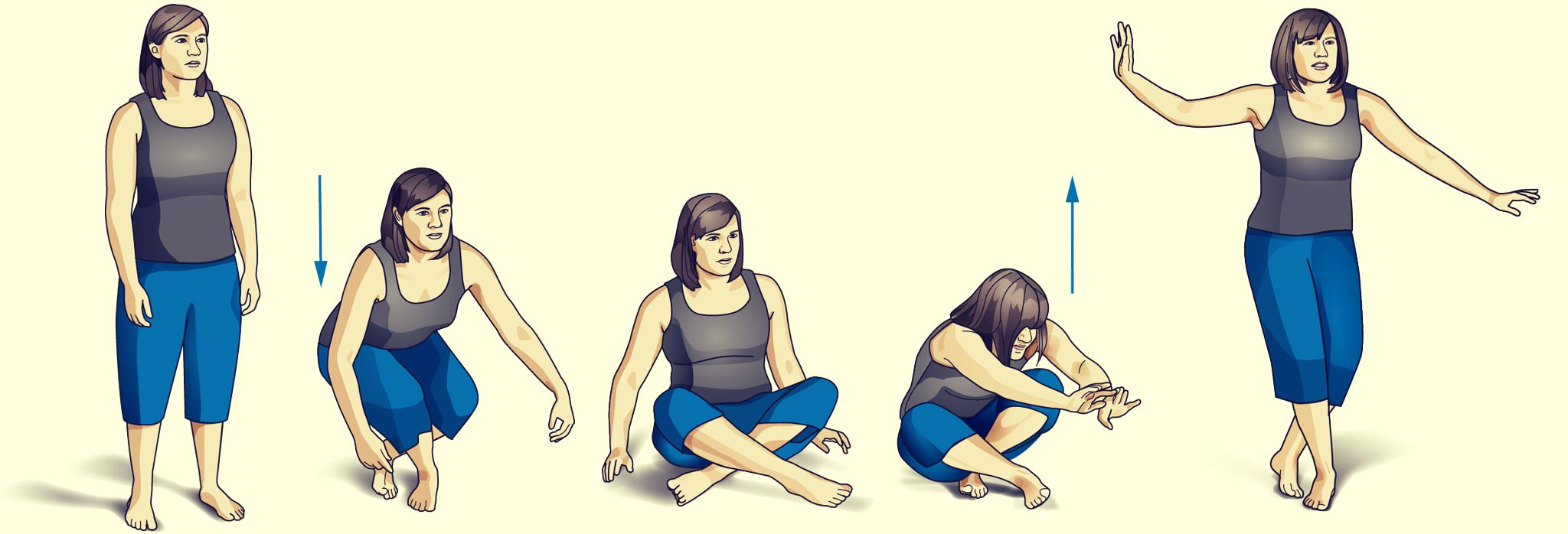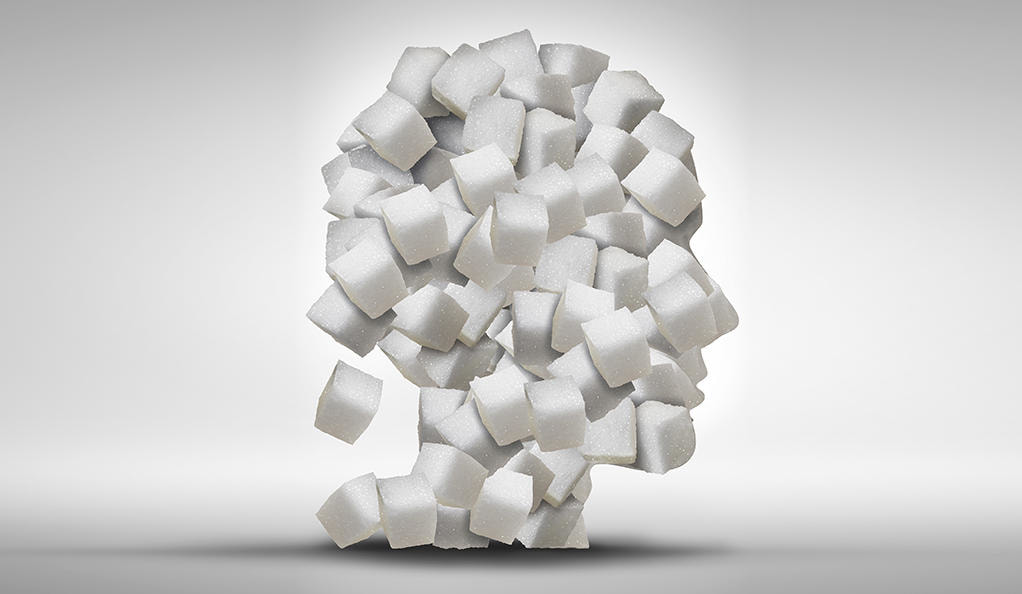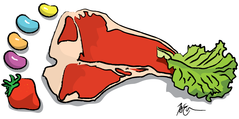 Red meat occupies the largest moeity of carbon footprint amongst all food categories Red meat occupies the largest moeity of carbon footprint amongst all food categories Everyone is busy exasperating over our kitchen waste polluting the environment, but nobody is thinking about what lands on our table is doing to the same environment even before it turns into waste! Very few know while the rest are conveniently ignoring the harsh fact that the food choices we make have a massive impact on the environment. Food before reaching our kitchen goes through a laborious process of production, processing transporting, selling and storing. The time taken to complete this cycle determines the carbon footprint of your comestibles. Carbon footprint is the amount of carbon dioxide emitted by a process associated with human activity. Be it a chemical plant or a crop, each process has its own carbon footprint. The food on our plate also has! Eating ‘green’ may sound clichéd, but is unarguably the only way we can direct our efforts towards reducing the environmental damage, a lot already done and even more in the pipeline. What is happening ? Pesticides and fertilizers going into crops have skyrocketed. They may accelerate and maintain crop growth but ambiguously pollute air and water quality apart from posing serious threat to health of farmers and workers. What can we do? Choose organically grown crops. And even better, if you have the space, grow them! They not only are healthier but also taste good, devoid of the causticity of pesticides and fertilizers. What is happening? A large chunk of fertile forest lands are being converted into grazing lands to grow animal feed like soy, corn etc. for livestock and meat industry. Methane released from digestive process of ruminants like cow, goat and sheet has a large carbon footprint. Seafood too is a big benefactor of carbon footprint with the amount of fossil fuel burnt in open-ocean fishing fleets. Producing livestock for human consumption dispenses almost 15% of the emitted global greenhouse gasses. What can we do? Eat from the lower half of the food chain: vegetables, fruits, limited quantity of dairy and less of red meat will surely cut down on your bit of contribution to global destruction!  Relish the local; what grows with nature, stays with nature. Relish the local; what grows with nature, stays with nature. What is happening? The mention of glamorous gourmet preparations undoubtedly makes us drivel in excitement. Imported exotic consumables and perishables like berries, nuts, greens use enormous energy resources for transportation, storage and most of them require high-end refrigeration. Needless to say, the carbon footprints left behind are gigantic. All our frozen goodies are the real baddies wearing colourful capes of deception! What can we do? Go local. Clichéd again. But works amazingly; not just for your health but also for the environment. Opt for fresh, locally and naturally grown fruits and vegetables. It may require an extra bit of effort but next time buy your stuff from a local market or directly from a farmer than dumping into the supermarket trolley. Not only will you help with your bit to cut down transportation footprinting but also are likelier to get fresher rations and greater satisfaction of helping a farmer get his/her due! Estimated by The Natural Resources Defense Council, that importing of fruits and vegetables contributes to smog-forming emissions equivalent to the annual CO2 emissions from 1.5 million cars! If this doesn’t alarm us then what will? Did you recently gobble up a pizza delivered from your favourite eating joint? While you were busy counting the number of pieces you will lay on hands on, the carbon footprint of your pizza delivered has been already tabbed and accounted! Based on statistical evaluations, a pizza restaurant on an average consumes:
All put together, it leaves us gasping for breath at the catastrophically whooping figure to deal with! We are all the time talking about mindful eating. But mindfulness is significant only if it helps maintain both physiological and ecological equilibrium. As against a heap of cheesy pork pasta, a locally grown organic fruit or vegetable footprints far less on the carbon dioxide scale and can be sustained for longer periods as practice due to its availability, digestibility, compost-friendliness and health turnover! On World Environment Day, put the first step forward. Stop your hands from pulling out that packet of frozen peas, visit the Sunday fruit market, ‘beef down’ you red meat consumption and instead of placing a home delivery order for your burger, walk down to the dining place tonight! Going green puts a great responsibility on not just what goes off our plates but what touches our palate. How often do you pinch your eyebrows and use the nearest support to get up from a grounded position? And by you, we assume, a normal 'un-ailing healthy' person. If your answer is quite often, then we have to unfortunately remove healthy from the paranthesis and all that remains is an 'unailing' not-so-healthy individual of you! Seeing young individuals unable to even get up from a chair without taking support, makes us wonder how miserably we have shelved health and fitness on the last rack of our priorities. Basic functional tasks like walking up the stairs, touching your toes or simply getting up in an upright position from a grounded one, they all pose a very important question to us: are we fit? Our strength doesn’t lie in the amount weight we plate onto the Smith machine, but in lifting our own weight with ease. Fitness is a conglomeration of various parameters and there cannot be an isolated test to calibrate our fitness quotient, but there is one such test that has been around for a while but gained popularity in the recent times to access our basic muscle strength and coordination: The Sitting-Standing Test. Designed in 2012 by Dr. Brazilian Claudio Gil Araújo, an exercise and sports-medicine expert, to assess muscle strength, balance and flexibility, this test evaluates your ability to sit on the floor and rise unaided, that is without using your hands, legs, elbows/forearms or knees for support. There are basically 5 ways of support we can seek during this activity: hand on floor, forearm on floor, knee on floor, side of the leg on floor and hand on the knee. You will surely relive your school days doing this because this activity comes with a scoreboard! These 5 support points form the basis of assessing your fitness level.
You are entitled to a maximum score of 10; 5 each for sitting and getting back up; and this is perhaps the only test you would have ever taken where you start with a full score, a perfect 10! But with every one support point you use, you lose a point on the your assessment sheet. Talk about reverse psychology! Oh wait, that doesn’t end there. You can lose an additional 0.5 points for an unsteady and wobbly execution. Now talk about reverse psychology hung-over with performance pressure! The good thing is that you are not assessed on your speed. You can choose to go slow or bolt up and down, as long as you are able to maintain your balance and not sacrifice that half a point on the altar of over-confidence! Sitting and getting up seem almost effortless and involuntary activities, but the amount of hard-work that goes behind them, only your muscles know. And by muscles, we mean a lot of them, not just one. The primary parts of our body that assist in sitting and standing and give us an erect posture are LEGS-our pillars, SPINE-the structural framework, and TORSO-our beam support.
Nobody is devoid of muscles. We all have every single muscle fibre genetically designed for Homo sapiens. But the strength, agility, flexibility and stability differs from one person to another. Foremost, we need to keep our muscles moving for them to function, and secondly, we need to constantly strengthen them in order to execute basic or advanced movements. Fundamental strength and functional training with or without weights, resistance exercise, yoga and cardiovascular exercises, are all essential in equity to provide strength, flexibility and balance to our body. It is incredible to see that the simplest of lifestyle activities can be such a crucial parameter to assess where we stand on our own fitness pedestral. The Sitting-Standing test is a fantastic yardstick to assess us impartially. It may burst our bubbles and dishearten us once our scores are chalked out, but like may other touchstones life throws at us, this too shall show us the mirror and prompt us to get our shoulders to the wheels. It is undoubtedly a world full of traffic jams, unsatisfactory jobs, and relationship heartburns. But then we also see early morning walkers, laughter clubbers, gym lovers, sportspersons and yogis. For every couch potato, there is a triathlete and for every broken new year resolution, there is the new gym opening in the neighbourhood! The balance hasn’t been lost as yet. We need to derive our motivation from the active and shun passivity. Someone rightly said “If you don’t take care of your body, where will you live in?” It is not important to be a heavy lifter, but to be functionally fit, is indispensable. So keep your muscles roaring and your SST score soaring! Have you been forgetting things lately? You forgot where you parked your car the evening you went clubbing with friends, or that Sunday family picnic trip got delayed because you couldn’t find your keys, or the days you travelled overseas on work and you forgot to take your phone charger along, or perhaps that exciting day of the week watching soccer finals with your friends and you had to order in some grub but you couldn’t recall where you placed your wallet! The worse wasn’t over; at a family reunion you couldn’t recognize your aunt who used to feed you with the best parathas and took you for city fairs!Now, do you recall what you had feasted upon on all the above-mentioned days? Definitely NO. Well, then your answer to the first question lies in that of the second. You certainly are having difficulties with the memory centre of your brain. And more than certainly, all the years of feasting has casted its spell on your hippocampus! Although these events of short term memory loss happen more often than we know with almost all of us at some point of time, they can be warning signs of an impending crisis; a pathological crisis which can lead to an irreversible damage to our cognitive functions. Memory loss and dementia are the hallmarks of the most common neurodegenerative disorder, Alzheimer’s disease. Although this disorder afflicts older adults, the symptoms and manifestations can be visible earlier in life too- the frequency and intensity of which may vary between individuals depending on factors like genetic disposition, lifestyle and presence of metabolic disorders. While truckload of research and inference has gone into the genetics and therapeutic aspects of it, very few are aware of a crucial link it has with another very critical facet of or diet, the sinful sugars. Memories... Tangled and Piled The brain functions primarily in 2 ways: one, using almost 25% of the blood supply of our body to obtain nutrients, and two, ensuring smooth neurotransmission across neurons to control all body functions. Any disruption in either of these can lead to serious brain dysfunctions. Unfortunately Alzheimer’s disease influences both these aspects. The role of amyloid beta protein has not been elucidated during normal functioning but in Alzheimer’s disease, it builds up into lumps or aggregates right at the synaptic junction between nerve cells and hampers effective neurotransmission. At the same time, another protein Tau which is otherwise responsible helping the framework of neurons stay organized to transport nutrients into the cells, undergoes phosphorylation and collapses into tangles or twisted strands. This causes the neuronal framework to collapse and start degenerating or disintegrating, thereby preventing any further entry of nutrients and essential supplies into the cell which eventually dies. For this reason, Alzheimer’s is called a neurodegenerative disorder. This brings us back to elucidating how diet can modulate neurodegeneration. Excessive sugar intake in our diet causes a large part of it to travel to the brain. Glucose is extremely essential for the brain towards various functions, but when there is more than what’s required, it turns catastrophic! Glucose causes damage proteins via a chemical reaction called ‘glycation’ that produces substances called Advanced Glycation End products (AGEs). These AGEs further modify amyloid beta proteins to form aggregates at the neuronal junctions. Simultaneously, AGEs through a complex signaling cascade cause phosphorylation of tau protein, which get restructured into tangles resulting in subsequent neurodegeneration. On the backend, a pivotal enzyme MIF is actively involved with our immune response to any possible accumulation of abnormally modified proteins. But in scenarios of excessive unwanted sugar intake, glucose yet again through glycation, modifies and inhibits the protective function of MIF. So, basically not only does it cause the damage but also constrains the protective mechanisms! The magnitude of casualty sugar can cause in the brain is inapprehensible. And for this very reason, diabetics are considered to be at higher risk of developing Alzheimer’s disease. Sugars, especially refined and simple ones like baked flour goodies, few cereals, sweets, aerated drinks and sweetened beverages should be totally avoided for metabolic as well as neurological wellness.
Sadly, there is no cure for Alzheimer’s disease. It is a disease of the aging and can be excruciatingly debilitating for the patients. There is no prophylaxis for it either, except a few minor lifestyle changes that can be incorporated to slow down the process. Cutting out those nasty sugars from our diet and following a balanced meal system with limited complex carbs and loads of fruits, vegetables and lean meat, is the best nunchaku for avoiding early onset of Alzheimer’s till ofcourse, genetics uses its chainsaw! If not prevent, a mind-ful diet can ameliorate manifestations of Alzheimer’s disease to a great extent. Baggages. We carry them everywhere; domestic issues, workplace stress, personal relations, heartburns of the past, and so many more. We shed a few as we travel up, but few baggages land up on our plates and travel straight down to our intestines! The dejected ones call it filling up the emptiness and the health experts implicate it as Emotional Eating: a condition where one uses food to satisfy their emotional hunger rather than their physiological hunger. Physiological hunger entails:
Emotional eating is purely based upon impulsion rather than nutritional requirement and the sufferer tends to binge upon foods that spike up their blood glucose levels to give a sense of fulfillment. Fries, chips, burgers, pizzas, ice creams, chocolates, cakes are some of the most exploited ones for instant gratification. Fluctuating mood and emotional cues like euphoria, sadness, depression, anxiety or general lack of interest can drive one towards emotional eating, turning food into a reward system for the brain to cope up with oscillating emotions. This reward system encapsulate 4 aspects:
Emotional eating is not just a temperamental mess to deal with. It has underlying physiological impacts, often long term, if not contained in its early phases. Since taste is the paramount criteria to lure a mind, the foods consumed are hyper-palatabile and act like addictive substances for the brain to generate a sense of pleasure. This hyper-palatability loaded with simple carbs, sweeteners, saturated fats and oils, it is nothing short of a catastrophe in disguise with metabolic disorders and obesity consequentially striking the system at lightning speed. What exactly goes wrong? It is all in the brain! Hypothalamus is a tiny part of the brain doing some big stuff out there. Apart from maintaining daily physiological functions, its key function is to regulate hormones, appetite, emotional responses and sexual behaviour. This hypothalamus has a complicated relationship with the ‘satiety hormone’ leptin. Leptin is the hormone for regulating energy expenditure through negative control of feeding. It inhibits appetite or hunger by signaling the hypothalamus when your calorific intake is sufficient enough thereby preventing you from overeating and gaining weight. It is produced liberally by adipocytes or fat cells in a simple mathematical proportion: more the fat cells, more leptin oozed out into the blood stream. By this logic, overweight or obese people should have more leptin floating around and should prohibit them from over- or binge-eating, but this does not happen. Rather, such individuals are more prone to binging and gaining further weight, making this mechanism more complex than it seems. Obesity figures in a walloping compromise on the leptin-hypothalamic axis. It renders the body leptin-resistant. In this condition, leptin, although is secreted normally by the adipocytes in response to high fat content, the brain refuses to acknowledge its presence. The pathophysiology of leptin resistance has not been clearly elucidated although diet-induced hypothalamic inflammation and leptin receptor mutations are considered to be the primary causes of it. As a result, the brain senses starvation while the body suffers obesity. Hunger remains unhindered and continues to bolt the body with more and more calories. 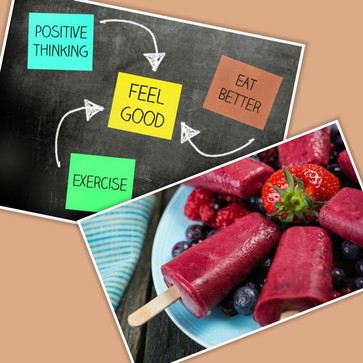 Lose the vulnerability. Gain Control. Lose the vulnerability. Gain Control. How do you clear the mess? Staggering back on trail is far less easy than going off-track. There is a monster to tame and you will have to give in, give up and give way to all that has been guzzling you offlate.
Emotional eating is not accomplished overnight. It creeps in stealthily from the dingiest corners of your heart and treks right upto the brain without any noise. The alarming part is that you lose control. It may start with just a handful of peanuts to munch on, moving on to gulping down a shake and before you realize you are neck deep in a tub of icecream! The other word for emotional eating is self-sabotage. Well, really. The magnitude of damage emotional eating can inflict on you is unimaginable. Once the orb of obesity is created, there is a gargantuan hill to cross. Nevertheless, there is always a plan B. Talk to your therapist, dietician or nutritionist for expert advice. You may have to work upon your emotions and also shed all those extra pounds you gained for polishing off the pizzas and chocolates before rearranging your physiology. Developing and practicing strategies to cope with the emotional turmoils are not always easy, yet achievable. Be gentle to yourself and tell yourself more than often than you can do it. Let not your emotions control your eating behaviour. They can weigh you down and can weigh you up too. Next time your emotions play the dirty devil and wheedle your cravings, remind yourself, food is fuel, not a reward! |
AuthorDietitian & Nutritionist Dr. Nafeesa Imteyaz. Archives
May 2020
Categories |
- Home
- Written Testimonials
- Consult
- Clinics
- Blogs
-
Diet & Nutrition
- Diabetes Reversal
- IVF IUI not needed for PCOS PCOD Infertility
-
Medical Nutrition
>
-
Disease & Conditions
>
- Infertility | PCOS
- Diabetes Mellitus
- Cholesterol
- Hypothyroid
- Kidney Problems
- Hypertension
- Cardiovascular Diseases
- Liver Diseases
- Gastro intestinal disorder
- Cancer
- Metabolic Disorders
- Orthopedic Disorders
- Eating Disorders
- Dietary Recall
- Weight Record Filled By Clients
- Online Payment Transaction Details
- Online Clients Weight Check Form
- Our Program Package Service Charges
- Weight Record 2017 Clients
- Measurements sent by Clients
- Terms & Conditions Of Payment
- Thanks. Your Form is Submitted
- Video Testimonials
- Lifestyle & Wellness
- Lifestyle & Wellness Blog
- Allergy & Intolerance
- Weight Loss / Gain
- Weight Loss / Slimming Blog
-
Disease & Conditions
>
- Life Cycle Nutrition >
- Sports Nutrition >
- Integrity in Nutrition
- Knowledge Centre
© COPYRIGHT 2022. ALL RIGHTS RESERVED. FRST HEALTHCARE PVT LTD.
Dr. Nafeesa Imteyaz of First Eat Right clinic, is the Best Dietitian Nutritionist in Bangalore. Best Dietitian Nutritionist in Pune. Best Dietitian Nutritionist in Hyderabad. Best Dietitian Nutritionist in Chennai. Best Dietitian Nutritionist in Mumbai. Best Dietitian Nutritionist in Delhi. Best Dietitian Nutritionist in Kolkata.



